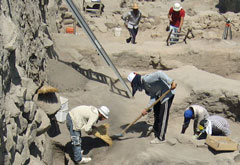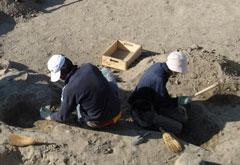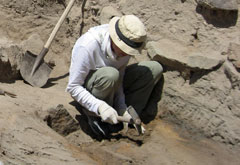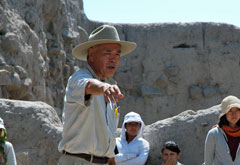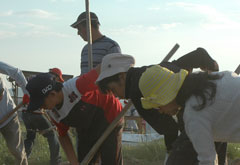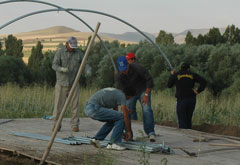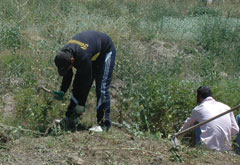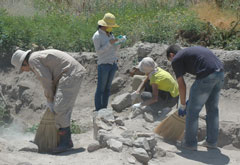- Excavation and General Survey >
- Kaman-Kalehöyük >
- 25th Excavation
Kaman-Kalehöyük
Dr. Sachihiro Omura Director, JIAA
25th Excavation and Survey at Kaman-Kalehöyük (2010)
Objective of survey
25th Excavation and Survey in Kaman-Kalehöyük was conducted from 19th July through to 7th September. On 6th of September, 51 pieces of those excavated remains which are suitable to be exhibited were deposited to the newly opened Kaman-Kalehöyük Archaeological Museum. Mr. Fat Özçatal (a curator at Eskişehir Archaeological Museum)who was dispatched to the excavation site left the site camp in the afternoon of thee 7th , by this the excavation and survey work at the site finished.
There were two survey objectives this year as past years. One is to compile “cultural stratigraphy” in the North Trench. So far 36 excavation sectors were surveyed and identified 4 cultural layers. This season, survey on the early Bronze Age, which will be set forth below, just before the Intermediate Period, in other words, IIIc layer, assumed to be the bottom layer of the Assyrian Colony Period was conducted. In the South Trench grasping and drawing the settlement style of each culture by means of survey in extensive excavation areas to identify the cultural style found in the North Trench is the objective, but this season, the settlement style in IId layer – early Iron Age was focused in excavation and survey work.
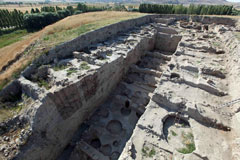
Picture 1: The North Trench at time of the finish of the excavation for this year.
From north west end of Kaman-Kalehöyük.
The Remains in the North Trench
In the North Trench, IIIc layer corresponding to the first quarter of the 2nd millennium B.C., in other words the mid term between the Assyrian Colony Period and IVa layer cultural layer was excavated. The Intermediate Period is between the early Bronze Age and the middle Bronze Age, and it is the end of the 3rd millennium to the beginning of the 2nd millennium B.C.
Excavation and survey in the North Trench was conducted by digging further down the deepest areas in sectors V through to VIII (Pictures 1 and 2). In sector V, there found walls which exceed 3m high stone walls being identified as the Assyrian Colony Period are found. There found IVa layer cultural layer was found at the south of the stone walls and the wall was built with scraping the IVa layer, which can be seen from the cross sections on both sides of the excavation sectors. This stone wall was identified in the mid 1990s, but the sun-dried bricks on upper structure were fallen down to the north. Removing the layer of fire including those fallen sun-dried bricks, there found many small fragments of earthenware and a path paved with pebbles. Crossing with over 3m high stone wall running west to east and the path paved with pebbles, robust rockwork architectural remains running north to south on the north of them are found in sectors V through to VII. Along this architectural remains, 1m wide path paved with small fragments of earthenware and pebbles is found on the north of the remains.
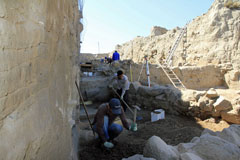
View of work site in the North Trench.
This season, the architectural remains in IIIc layer running north to south was removed and detail survey on the west of the paved path was conducted. The west side of the path is covered with groups of pits and each of them was dug down carefully, but distinctive architectural remains ware not found in sectors V through to VI. Fragmented earthenware found in sector V partly involve hand made ones and it is suggesting that the IVa layer is close. In sector VI, architectural remains with poor conservation condition were found while surveying pits. Though it was short stone wall and a little floor, gold items were found on the floor. Judging from items found nearby the gold item, this place must have been a studio. In sector VII, architectural remains running north to south excavated in sectors V through to VI was partially removed. Simultaneously the IIIb layer, the architectural remains of the Old Hittite Kingdom Period that were found in the north of sector VII were removed. It is observed that form the west cross sections of these architectural remains of the Old Hittite Kingdom Period, they were built demolishing the architectural remains of the Assyrian Colony Period.
Remains in the South Trench
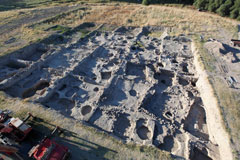
Picture 3: Overview of the South Trench at time
of finish of the excavation for this year.
From north west of Kaman-Kalehöyük.
In the South Trench, survey on the cultural layer on the Iron Age as past years. This season, excavation in the cultural layer of IId, 12th to 9th B.C cultural layers, it has been called “Dark Age” in Anatolian Archaeology (Pictures 3 and 4). Through the survey this time, there are at least 4 architectural layers in the South Trench of IId layer, each of them was burnt, holes of column ware found in every architectural remain in IId layer and corners of architectural remains are round. There found the architectural remains of IIc layer just above IId layer and it is almost certain that the culture of IIc was structured on the culture of IId layer.
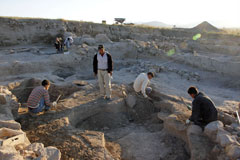
Picture 4: View of work site in the South Trench.
There found groups of pit belonging to IId layer in sector LI in the South Trench and there found layer of fire beneath the walls of pits. Judging from excavated remains it is likely that these fire layers are parts of layers of major fire in IIIc layer, the Assyrian Colony Period found in sectors 0, XII, XXVII, XXVIII, XXX and so forth. When removing these groups of pits in IId layer, cultural layers of the 2nd millennium B.C. could be found.
Excavated Remains
There were many of remains excavated in excavating and survey in the North and the South Trenches. In the North Trench, gold items, stamp seals, needles, pins, bronze drills etc. spindle wheels and earthenware are found in IIIc layer, the Assyrian Colony Period in the North Trench. There found some fragments of earthenware with engraved patterns which do not belong to the IIIc layer and these items could be of the 4th millennium B.C., the Chalcolithic Age. There found painted earthenware of IId layer and iron items are found from the floors of architectural remains in the South Trench. In IIc layer located just above IId layer, painted earthenware with animal figures are found. Other than these in the South Trench, bronze pins, earthenware with no figures, spindle wheels, grass buttons are found and there found many fragments of earthenware of early 2nd millennium B.C. in sector LI.
Acknowledgements
The excavation and survey in Kaman-Kalehöyük has been supported by many of supporting bodies by ways of subsidies and aid money. We are grateful for all such supports extended to us and the following are names of bodies subsidized in 2010.
- Japan Society for the Promotion of Science
- Japan Keirin Association

- Sumitomo Foundation
- Foundation for Cultural Heritage and Art Research
- Shinnyo-en
- Japan Tabacco Inc.
Progress of 25th Excavation and Survey in Kaman-Kalehöyük
Excavation and Survey started on 19th July progresses satisfactorily. There was heat wave in central Anatolia in early to middle August and the survey has been progressing without any interruption.
Compiling “cultural stratigraphy” is the objective in the North Trench and cultural layers in IIIc layer, Assyrian Colony Period to IVa layers, mid term in excavation sectors V, VI and VII in the North Trench have been further dug down. The IV layer belongs to the 3rd millennium B.C., in other words, early Bronze Age. Till today there are few excavations from upper layer to lower layer of the 3rd millennium B.C. in the Anatolian archaeology and especially this age has been “unclarified age” in central Anatolia. There are many earthenware and bronze ware excavated till now. In the South Trench, IIc layer, 8th B.C. of the Iron Age, IId layer, 11th to 9th B.C. cultural layers are surveyed in the South Trench. Particularly IId layer is the “Dark Age” layer, so the survey has been conducted carefully. There are many painted earthenware excavated from this layer. One of peculiarity of this layer is every excavated architectural remains in IId layer are seen marks of strong fire. There found many carbonized beams which must have been dropped from upper parts of buildings by the fire and there found number of holes of column on the floor which are not seen in the other ages. It is planed to see what and how the culture in IId layer influenced the culture of IIc layer locating just above IId.
25th Excavation and Survey in Kaman-Kalehöyük (2010) has been commenced
25th excavation and survey in Kaman-Kalehöyük has been commenced on Monday, 19th July. The first survey objective for this season is to dig down cultural layer of early Bronze Age, the second is to survey the early Iron Age layer in the South Trench. In central Anatolia, ages before cuneiform was introduce from Mesopotamia in the beginning of the 2nd millennium B.C. is named prehistoric time without characters, there are many of issues to be clarified. It can be named another “Dark Age” in Anatolian Archaeology. In the North Trench, early Bronze Age will be focused on in survey process. In the South Trench, the cultural layers of so called “Dark Age” in 10th to 9th B.C. will be excavated as has been done last year.
On 19th and 20th the excavation site was cleaned and as from 21st excavation work commenced. There is Mr. Fat Özçatal (a curator of archaeological museum of Eskişehir) is dispatched to the site as an inspector from the ministry of Culture and Tourism.
